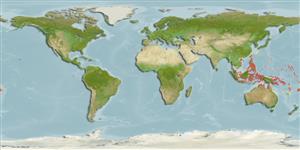Common names from other countries
>
Blenniiformes (Blennies) >
Blenniidae (Combtooth blennies) > Salariinae
Etymology: Blenniella: Diminutive of blennius, Greek,blenios = mucus (Ref. 45335).
More on author: Bleeker.
Environment: milieu / climate zone / depth range / distribution range
البيئة
بحري مرتبطة بالشعاب; نطاق العمق 0 - 2 m (Ref. 90102), usually 0 - 1 m (Ref. 9962). Tropical
Western Pacific: Taiwan to Indonesia and Efate, New Hebrides (Vanuatu).
الحجم / وزن / العمر
Maturity: Lm ? range ? - ? cm
Max length : 6.0 cm SL ذكر/ مختلط الجنس; (Ref. 9962); 5.1 cm SL (female)
الأشواك الظهرية (المجموع) : 12 - 14; الأشعة الظهرية الناعمة (المجموع) : 18 - 21; شوكة شرجية: 2; أشعه شرجية لينه: 19 - 22; فقرات: 37 - 40. Dorsal fin XII-XIV, 18-21, notched between spinous and segmented-ray portions; anal fin II, 19-22; pectoral rays 12-15; pelvic fin I, 3. Vertebrae 11-12 + 26-28. Orbital cirrus simple filamentous; nasal cirri short and simple to palmate with 2-6 branches; nape with cirri. Lateral line, continuous anterodorsally below dorsal spines from 4th to 10th, disconnected posteroventrally up to below dorsal spine 7-8th to 12-13th. Mandibular pores 4-6 Lips margin entire. Occipital crest present only in males, and only 0.7 mm or lower. Meristic characters slightly vary geographically, increasing from north to south (Ref. 9962). Body depth at anal-fin origin 5.3-6.0 in SL. Male grey to dark brown with longitudinal rows of blue dashes. Female pale grey with dark horizontal dashes and vertical dark A/H-shaped bars; dorsal and caudal fins spotted (Ref. 90102).
Found solitary or groups (Ref. 90102) near-shore rocky areas, including tide pools and at depths usually less than 1 meter (Ref. 9962). Oviparous. Eggs are demersal and adhesive (Ref. 205), and are attached to the substrate via a filamentous, adhesive pad or pedestal (Ref. 94114). Larvae are planktonic, often found in shallow, coastal waters (Ref. 94114).
Life cycle and mating behavior
Maturities | التكاثر | Spawnings | Egg(s) | Fecundities | Larvae
Distinct pairing (Ref. 205).
Springer, V.G. and J.T. Williams, 1994. The Indo-West Pacific blenniid fish genus Istiblennius reappraised: a revision of Istiblennius, Blenniella, and Paralticus, new genus. Smithson. Contrib. Zool. 565:1-193. (Ref. 9962)
IUCN Red List Status (Ref. 130435)
CITES (Ref. 128078)
Not Evaluated
استخدامات بشرية
أدوات
تقارير خاصة
Download XML
مصادر علي الأنترنت
Estimates based on models
Preferred temperature (Ref.
115969): 27.4 - 29.4, mean 28.8 (based on 963 cells).
Phylogenetic diversity index (Ref.
82804): PD
50 = 0.5020 [Uniqueness, from 0.5 = low to 2.0 = high].
Bayesian length-weight: a=0.00741 (0.00335 - 0.01640), b=3.02 (2.83 - 3.21), in cm Total Length, based on LWR estimates for this (Sub)family-body shape (Ref.
93245).
مستوى غذائي (Ref.
69278): 2.9 ±0.3 se; based on size and trophs of closest relatives
المرونه (Ref.
120179): عالي, الحد الزمني الأدني لتضاعف عدد أفراد المجتمع أقل من 15 شهر (Preliminary K or Fecundity.).
Fishing Vulnerability (Ref.
59153): Low vulnerability (10 of 100).
